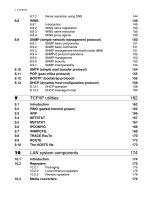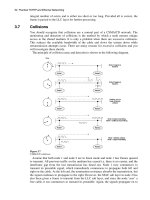Practical TCP/IP and Ethernet Networking- P25 ppt
Bạn đang xem bản rút gọn của tài liệu. Xem và tải ngay bản đầy đủ của tài liệu tại đây (79.77 KB, 10 trang )
6XGIZOIGR:)6/6GTJ+ZNKXTKZ4KZ]UXQOTM
that travels with a signal coming back through the configuration table; thus obtaining all
addresses.
To remove this potential weakness of dynamic IP address allocation, firewalls can track
the TCP sequence numbers and port numbers of originating TCP/IP connections. In order
for spoofers to penetrate the firewall to reach an end server, they would need not only the
IP address, but the port number and TCP sequence numbers as well.
To minimize the possibility of unauthorized network penetration, some firewalls also
support sequence number randomization, a process that prevents potential IP address
spoofing attacks, as described in a Security Advisory (CA-95:01) from the Computer
Emergency Response Team (CERT). Essentially, this advisory proposes to randomize
TCP sequence numbers in order to prevent spoofers from deciphering these numbers and
then hijacking sessions. By using a randomizing algorithm to generate TCP sequence
numbers, the firewall then makes this spoofing process extremely difficult, if not
impossible. In fact, the only accesses that can occur through this type of firewall are
those made from designated servers, which network administrators configure with a
dedicated ‘conduit’ through the firewall to a specific server – and that server alone.
*3@YJKSOROZGXO`KJ`UTKY
Most firewalls have two ports, one connected to the intranet and the other to the outside
world. The problem arises: on which side does one place a particular (e.g. WWW, FTP or
any other application) server? On either side of the firewall the server is exposed to
attacks, either from insiders or from outsiders.
In order to address this problem, some firewalls have a third port, protected from both
the other ports, leading to a so-called DMZ or de-militarized zone. A server attached to
this port is protected from attacks, both from inside and outside.
9ZXOQKHGIQOTZX[JKXXKYVUTYK
Some firewalls have a so-called intruder response function. If an attack is detected or an
alarm is triggered, it collects data on the attackers, their source, and the route they are
using to attack the system. They can also be programmed to automatically print these
results, e-mail them to the designated person, or initiate a real-time response via SNAP or
a pager.
Some firewalls will even send out a global distress call to all its peers (from the same
manufacturer) and inform them of the origin of the attack. Although the actual attacker
may be incognito, the router of his ISP is not, and can easily be traced. All the firewalls
then start pinging the ISP’s router ‘to death’ to slow it down or disable it.
'VVROIGZOUTRG_KXLOXK]GRRY
Application layer firewalls generally are hosts running proxy servers, and perform
basically the same function as network layer firewalls, although in a slightly different
way. Basically, an application layer firewall acts as an ambassador for a LAN or intranet
connected to the Internet. Proxies tend to perform elaborate logging and auditing of all
the network traffic intended to pass between the LAN and the outside world, and can
cache (store) information such as web pages so that the client accesses it internally rather
than directly from the Web.
A proxy server or application layer firewall will be the only Internet connected machine
on the LAN. The rest of the machines on the LAN have to connect to the Internet via the
proxy server, and for them Internet connectivity is just simulated.
Because no other machines on the network are connected to the Internet, a valid IP
address is not needed for every machine. Application layer firewalls are very effective for
small office environments that are connected with a leased line and do not have allocated
9KI[XOZ_IUTYOJKXGZOUTY
IP address blocks. They can even perform a dial-up connection on behalf of a LAN, and
manage e-mail and any other Internet requests.
They do, however, have some drawbacks. Since all hosts on the network have to access
the outside world via the proxy, any machine on the network that requires Internet access
usually needs to be configured for the proxy. A proxy server hardly ever functions at a
level completely transparent to the users. Furthermore, a proxy has to provide all the
services that a user on the LAN uses, which means that there is a lot of server type
software running for each request. This results in a slower performance than that of a
network layer firewall.
5ZNKXZ_VKYULLOXK]GRRY
Stateful inspection firewalls are becoming very popular. They are software firewalls
running on individual hosts and monitor the state of any active network connection on
that host, and based on this information determines what packets to accept or reject. This
is an active process that does not rely on any static rules. Generally speaking this is one
of the easiest firewalls to configure or use.
/TZX[YOUTJKZKIZOUTY_YZKSY/*9
Intrusion detection is a new technology that enables network and security administrators
to detect patterns of misuse within the context of their network traffic. IDS is a growing
field and there are several excellent intrusion detection systems available today, not just
traffic monitoring devices.
These systems are capable of centralized configuration management, alarm reporting,
and attack info logging from many remote IDS sensors. IDS systems are intended to be
used in conjunction with firewalls and other filtering devices, not as the only defence
against attacks.
There are two ways that intrusion detection is implemented in the industry today: host-
based systems and network-based systems.
.UYZHGYKJ/*9
Host-based intrusion detection systems use information from the operating system audit
records to watch all operations occurring on the host on which the intrusion detection
software has been installed. These operations are then compared with a pre-defined
security policy. This analysis of the audit trail, however, imposes potentially significant
overhead requirements on the system because of the increased amount of processing
power required by the intrusion detection software. Depending on the size of the audit
trail and the processing power of the system, the review of audit data could result in the
loss of a real-time analysis capability.
4KZ]UXQHGYKJ/*9
Network-based intrusion detection, on the other hand, is performed by dedicated devices
(probes) that are attached to the network at several points and passively monitor network
activity for indications of attacks. Network monitoring offers several advantages over
host-based intrusion detection systems. Because intrusions might occur at many possible
points over a network, this technique is an excellent method of detecting attacks which
may be missed by host-based intrusion detection mechanisms.
The greatest advantage of network monitoring mechanisms is their independence from
reliance on audit data (logs). Because these methods do not require input from any
6XGIZOIGR:)6/6GTJ+ZNKXTKZ4KZ]UXQOTM
operating system’s audit trail they can use standard network protocols to monitor
heterogeneous sets of operating systems and hosts.
Independence from audit trails also frees network-monitoring systems from possessing
an inherent weakness caused by the vulnerability of the audit trail to attack. Intruder
actions, which interfere with audit functions or which modify audit data can lead to the
prevention of intrusion detection or the inability to identify the nature of an attack.
Network monitors are able to avoid attracting the attention of intruders by passively
observing network activity and reporting unusual occurrences.
Another significant advantage of detecting intrusions without relying on audit data is
the improvement of system performance, which results from the removal of the overhead
imposed by the analysis of audit trails. In addition, techniques, which move the audit
data across network connections, reduce the bandwidth available to
other functions.
9KI[XOZ_SGTGMKSKTZ
)KXZOLOIGZOUT
Certification is the process of proving that the performance of a particular piece of
equipment conforms to the laid-down policies and specifications. Whereas this is easy in
the case of electrical wiring and wall sockets, where Underwriters’ Laboratory can certify
the product, it is a different case with networks where no official bodies and/or guidelines
exist.
If one needs a certified network security solution, there are only two options viz:
• Trusting someone else’s assumptions about one’s network
• Certifying it oneself
It is possible to certify a network by oneself. This exercise will demand some time but
will leave the certifier with a deeper knowledge of how the system operates.
The following are needed for self-certification:
• A company policy that favors security
• A security policy (see next section)
• Some basic knowledge of TCP/IP networking
• Access to the Web
• Time
To simplify this discussion, we will assume we are certifying a firewall configuration.
Let us look at each individually.
'IUSVGT_VUROI_ZNGZLG\UXYYKI[XOZ_
One of the biggest weaknesses in security practice is the large number of cases in which a
formal vulnerability analysis finds a hole that simply cannot be fixed. Often the causes
are a combination of existing network conditions, office politics, budgetary constraints, or
lack of management support. Regardless of who is doing the analysis, management needs
to clear up the political or budgetary obstacles that might prevent implementation of
security.
9KI[XOZ_IUTYOJKXGZOUTY
9KI[XOZ_VUROI_
In this case, ‘policy’ means the access control rules that the network security product is
intended to enforce. In the case of the firewall, the policy should list:
• The core services that are being permitted back and forth.
• The systems to which those services are permitted
• The necessary controls on the service, either technical or behavioral
• The security impact of the service
• Assumptions that the service places on destination systems
(GYOI:)6/6QTU]RKJMK
Many firewalls expose details of TCP/IP application behavior to the end user.
Unfortunately, there have been cases where individuals bought firewalls and took
advantage of the firewall’s easy ‘point and click’ interface, believing they were safe
because they had a firewall. One needs to understand how each service to be allowed in
and out operates, in order to make an informed decision about whether or not to permit it.
'IIKYYZUZNK=KH
When starting to certify components of a system, one will need to research existing holes
in the version of the components to be deployed. The Web, and its search engines, are an
invaluable tool for finding vendor-provided information about vulnerabilities, hacker-
provided information about vulnerabilities, and wild rumors that are totally inaccurate.
Once the certification process has been deployed, researching the components will be a
periodic maintenance effort.
:OSK
Research takes time, and management needs to support this and to invest the time
necessary to do the job right. Depending on the size/complexity of the security system in
question, one could be looking at anything between a day’s work and several weeks.
/TLUXSGZOUTYKI[XOZ_VUROIOKY
The ultimate reason for having security policies is to save money.
This is accomplished by:
• Minimizing cost of security incidents; accelerating development of new
application systems
• Justifying additional amounts for information security budgets
• Establishing definitive reference points for audits
In the process of developing a corporate security consciousness, one will, amongst
other things, have to:
• Educate and train staff to become more security conscious
• Generate credibility and visibility of the information security effort by
visibly driving the process from a top management level
• Assure consistent product selection and implementation
• Coordinate the activities of internal decentralized groups
The corporate security policies are not only limited to minimize the possibility on
internal and external intrusions, but also to:
6XGIZOIGR:)6/6GTJ+ZNKXTKZ4KZ]UXQOTM
• Maintain trade secret protection for information assets
• Arrange contractual obligations needed for legal action
• Establish a basis for disciplinary actions
• Demonstrate quality control processes for example ISO 9000 compliance
The topics covered in the security policy document should, for example, include:
• Web pages
• Firewalls
• Electronic commerce
• Computer viruses
• Contingency planning
• Internet usage
• Computer emergency response teams
• Local area networks
• Electronic mail
• Telecommuting
• Portable computers
• Privacy issues
• Outsourcing security functions
• Employee surveillance
• Digital signatures
• Encryption
• Logging controls
• Intranets
• Microcomputers
• Password selection
• Data classification
• Telephone systems
• User training
In the process of implementing security policies, one need not re-invent the wheel.
Products such as Information Security Policies Made Easy are available in a hardcopy
book and CD-ROM. By using a word processing package, one can generate or update a
professional policy statement in a couple of days.
9KI[XOZ_GJ\OYUX_YKX\OIKY
There are several security advisory services available to the systems administrator. This
section will deal with only three of them, as examples.
3OIXUYULZ
All software vendors issue security advisories from time to time, warning users about
possible vulnerabilities in their software. A particular case in point is Microsoft’s
advisory regarding the Word97 template security, which was issued on 19 January 1999.
This weakness was exploited by a devious party who subsequently devised the Melissa
virus. See Section 14.6 for a Web address.
9KI[XOZ_IUTYOJKXGZOUTY
)+8:
The CERT (Computer Emergency Response Team) co-ordination center is based at the
Carnegie Mellon Software Engineering Institute and offers a security advisory service on
the Internet. Their services include:
• CERT advisories
• Incident notes
• Vulnerability notes
• Security improvement modules
The latter include topics such as:
• Detecting signs of intrusions
• Security for public web sites
• Security for information technology service contracts
• Securing desktop stations
• Preparing to detect signs of intrusion
• Responding to intrusions
• Securing network services
These modules can be downloaded from the Internet in PDF or PostScript versions and
are written for system and network administrators within an organization. These are the
people whose day-to-day activities include installation, configuration and maintenance of
the computers and networks.
Once again, a particular case in point is the CERT/CC CA-99-04-MELISSA-MICRO-
VIRUS.HTML dated March 27, 1999 which deals with the Melissa virus which was first
reported at approximately 2:00 pm GMT-5 on Friday, 26 March 1999. This example
indicates the swiftness with which organizations such as CERT react
to threats.
)9/
CSI (The Computer Security Institute) is a membership organization specifically
dedicated to serving and training the information computer and network security
professionals. CSI sponsors two conferences and exhibitions each year: NetSec in June
and the CSI Annual in November. CSI also hosts seminars on encryption, intrusion,
management, firewalls and awareness. They also publish surveys and reports on topics
such as computer crime and information security program assessment.
:NKV[HROIQK_OTLXGYZX[IZ[XK61/
/TZXUJ[IZOUTZUIX_VZUMXGVN_
The concept of securing messages through cryptography has a long history. Indeed,
Julius Caesar is credited with creating one of the earliest cryptographic systems to send
military messages to his generals.
Throughout history, however, there has been one central problem limiting widespread
use of cryptography. That problem is key management. In cryptographic systems, the
term key refers to a numerical value used by an algorithm to alter information, making
that information secure and visible only to individuals who have the corresponding key to
recover the information. Consequently, the term key management refers to the secure
administration of keys to provide them to users where and when they are required.
6XGIZOIGR:)6/6GTJ+ZNKXTKZ4KZ]UXQOTM
Historically, encryption systems used what is known as symmetric cryptography.
Symmetric cryptography uses the same key for both encryption and decryption. Using
symmetric cryptography, it is safe to send encrypted messages without fear of
interception, because an interceptor is unlikely to be able to decipher the message.
However, there always remains the difficult problem of how to securely transfer the key
to the recipients of a message so that they can decrypt the message.
A major advance in cryptography occurred with the invention of public-key
cryptography. The primary feature of public-key cryptography is that it removes the need
to use the same key for encryption and decryption. With public-key cryptography, keys
come in pairs of matched ‘public’ and ‘private’ keys. The public portion of the key pair
can be distributed in a public manner without compromising the private portion, which
must be kept secret by its owner. Encryption done with the public key can only be undone
with the corresponding private key.
Prior to the invention of public-key cryptography, it was essentially impossible to
provide key management for large-scale networks. With symmetric cryptography, as the
number of users increases on a network, the number of keys required to provide secure
communications among those users increases rapidly. For example, a network of 100
users would require almost 5000 keys if it used only symmetric cryptography. Doubling
such a network to 200 users increases the number of keys to almost 20 000. Thus, when
only using symmetric cryptography, key management quickly becomes unwieldy even for
relatively small-scale networks.
The invention of public-key cryptography was of central importance to the field of
cryptography and provided answers to many key management problems for large-scale
networks. For all its benefits, however, public-key cryptography did not provide a
comprehensive solution to the key management problem.
Indeed, the possibilities brought forth by public-key cryptography heightened the need
for sophisticated key management systems to answer questions such as the following:
• The encryption of a file once for a number of different people using
public-key cryptography
• The decryption of all files that were encrypted with a specific key in case the
key gets lost
• The certainty that a public key apparently originated from a specific
individual is genuine and has not been forged by an imposter
• The assurance that a public key is still trustworthy
The next section provides an introduction to the mechanics of encryption and
digital signatures.
+TIX_VZOUTGTJJOMOZGRYOMTGZ[XKK^VRGOTKJ
To better understand how cryptography is used to secure electronic communications, a
good everyday analogy is the process of writing and sending a cheque to a bank.
Remember that both the client and the bank are in possession of matching private
key/public key sets. The private keys need to be guarded closely, but the public keys can
be safely transmitted across the Internet since all it can do is unlock a message locked
(encrypted) with its matching private key. Apart from that it is pretty useless to anybody
else.
9KI[XOZ_IUTYOJKXGZOUTY
9KI[XOTMZNKKRKIZXUTOIKW[O\GRKTZULZNKINKW[K
The simplest electronic version of the cheque can be a text file, created with a word
processor, asking a bank to pay someone a specific sum. However, sending this cheque
over an electronic network poses several security problems:
6XO\GI_
Enabling only the intended recipient to view an encrypted message. Since anyone could
intercept and read the file, confidentiality is needed.
'[ZNKTZOIGZOUT
Ensuring that entities sending the messages, receiving messages, or accessing systems are
who they say they are, and have the privilege to undertake such actions. Since someone
else could create a similar counterfeit file, the bank needs to authenticate that it was
actually you who created the file.
4UTXKV[JOGZOUT
Establishing the source of a message so that the sender cannot later claim that they did
not send the message. Since the sender could deny creating the file, the bank needs non-
repudiation.
)UTZKTZOTZKMXOZ_
Guaranteeing that messages have not been altered by another party since they were sent.
Since someone could alter the file, both the sender and the bank need data integrity.
+GYKUL[YK
Ensuring that security systems can be consistently and thoroughly implemented for a
wide variety of applications without unduly restricting the ability of individuals or
organizations to go about their daily business.
To overcome these issues, the verification software performs a number of steps hidden
behind a simple user interface. The first step is to ‘sign’ the cheque with a digital
signature.
*OMOZGRYOMTGZ[XK
The process of digitally signing starts by taking a mathematical summary (called a hash
code) of the cheque. This hash code is a uniquely identifying digital fingerprint of the
cheque. If even a single bit of the cheque changes, the hash code will dramatically
change.
The next step in creating a digital signature is to sign the hash code with the sender’s
private key. This signed hash code is then appended to the cheque.
How is this a signature? Well, the recipient (in this case the bank) can verify the hash
code sent to it, using the sender’s public key. At the same time, a new hash code can be
created from the received check and compared with the original signed hash code. If the
hash codes match, then the bank has verified that the cheque has not been altered. The
bank also knows that only the genuine originator could have sent the cheque because only
he has the private key that signed the original hash code.
)UTLOJKTZOGROZ_GTJKTIX_VZOUT
Once the electronic cheque is digitally signed, it can be encrypted using a high-speed
mathematical transformation with a key that will be used later to decrypt the document.
This is often referred to as a symmetric key system because the same key is used at both
ends of the process.
6XGIZOIGR:)6/6GTJ+ZNKXTKZ4KZ]UXQOTM
As the cheque is sent over the network, it is unreadable without the key, and hence
cannot be intercepted. The next challenge is to securely deliver the symmetric key to the
bank.
6[HROIQK_IX_VZUMXGVN_LUXJKRO\KX_Y_SSKZXOIQK_Y
Public-key encryption is used to solve the problem of delivering the symmetric
encryption key to the bank in a secure manner. To do so, the sender would encrypt the
symmetric key using the bank’s public key. Since only the bank has the corresponding
private key, only the bank will be able to recover the symmetric key and decrypt
the cheque.
Why use this combination of public-key and symmetric cryptography? The reason is
simple. Public-key cryptography is relatively slow and is only suitable for encrypting
small amounts of information – such as symmetric keys. Symmetric cryptography is
much faster and is suitable for encrypting large amounts of information such as files.
Organizations must not only develop sound security measures, they must also find a
way to ensure consistent compliance with them. If users find security measures
cumbersome and time consuming to use, they are likely to find ways to circumvent them
– thereby putting the company’s Intranet at risk.
Organizations can ensure the consistent compliance to their security policy through:
• Systematic application
The system should automatically enforce the security policy so that security
is maintained at all times
• Ease of end-user deployment
The more transparent the system is, the easier it is for end-users to use – and
the more likely they are to use it. Ideally, security policies should be built
into the system, eliminating the need for users to read detailed manuals and
follow elaborate procedures
• Wide acceptance across multiple applications
The same security system should work for all applications a user is likely to
employ. For example, it should be possible to use the same security system
whether one wants to secure e-mail, e-commerce, server access via a
browser, or remote communications over a virtual private network
61/JKLOTOZOUTV[HROIQK_OTLXGYZX[IZ[XK
Imagine a company that wants to conduct business electronically, exchanging quotes and
purchase orders with business partners over the Internet.
Parties exchanging sensitive information over the Internet should always digitally sign
communications so that:
• The sender can securely identify themselves – assuring business partners that
the purchase order really came from the party claiming to have sent it
(providing a source authentication service)
• An entrusted third party cannot alter the purchase orders to request
hypodermic needles instead of sewing needles (data integrity)
If a company is concerned about keeping the nature of particulars of their business
private, they may also choose to encrypt these communications (confidentiality).
The most convenient way to secure communications on the Internet is to employ
public-key cryptography techniques. But before doing so, the user will need to find and
9KI[XOZ_IUTYOJKXGZOUTY
verify the public keys of the party with whom he or she wishes to communicate. This is
where a public-key infrastructure comes in.
61/L[TIZOUTY
A successful public-key infrastructure needs to perform the following:
• Certify public keys (by means of certification authorities)
• Store and distribute public keys
• Revoke public keys
• Verify public keys
Let us now look at each of these in turn.
)KXZOLOIGZOUTG[ZNUXOZOKY
Deploying a successful public-key infrastructure requires looking beyond technology. As
one might imagine, when deploying a full scale PKI system, there may be dozens or
hundreds of servers and routers, as well as thousands or tens of thousands of users with
certificates. These certificates form the basis of trust and interoperability for the entire
network. As a result, the quality, integrity, and trustworthiness of a public-key
infrastructure depend on the technology, infrastructure, and practices of the certificate
authority that issues and manages these certificates.
Certificate authorities (CA) have several important duties. First and foremost, they must
determine the policies and procedures, which govern the use of certificates throughout the
system.
The CA is a ‘trusted third party’, similar to a passport office, and its duties include:
• Registering and accepting applications for certificates from end users and
other entities
• Validating entities’ identities and their rights to receive certificates
• Issuing certificates
• Revoking, renewing, and performing other life cycle services on certificates
• Publishing directories of valid certificates
• Publishing lists of revoked certificates
• Maintaining the strictest possible security for the CA’s private key
• Ensure that the CA’s own certificate is widely distributed
• Establishing trust among the members of the infrastructure
• Providing risk management
Since the quality, efficiency and integrity of any PKI depends on the CA, the
trustworthiness of the CA must be beyond reproach.
On the one end of the spectrum, certain users prefer one centralized CA, which controls
all certificates. Whilst this would be the ideal case, the actual implementation would be a
mammoth task.
At the other end of the spectrum, some parties elect not to employ a central authority
for signing certificates. With no CAs, the individual parties are responsible for signing
each other’s certificates. If a certificate is signed by the user or by another party trusted
by the user, then the certificate can be considered valid. This is sometimes called a ‘web
of trust’ certification model. This is the model popularized by the PGP (pretty good
privacy) encryption product.









